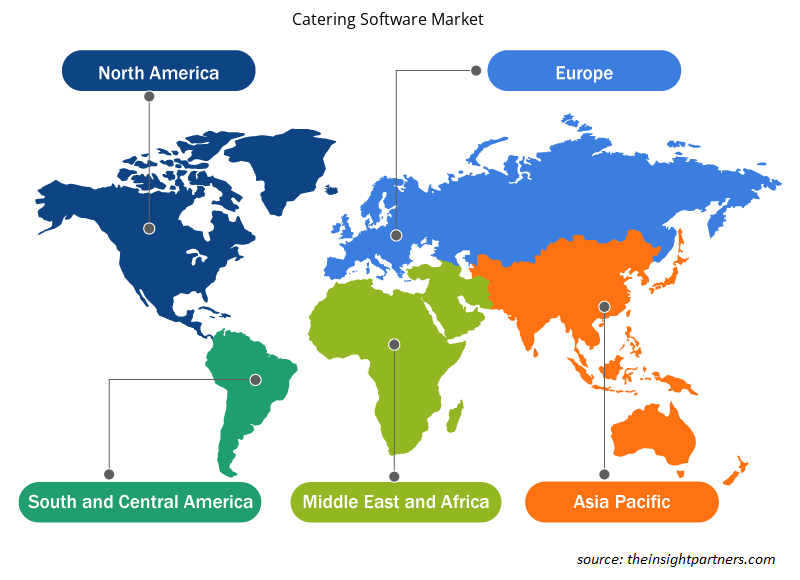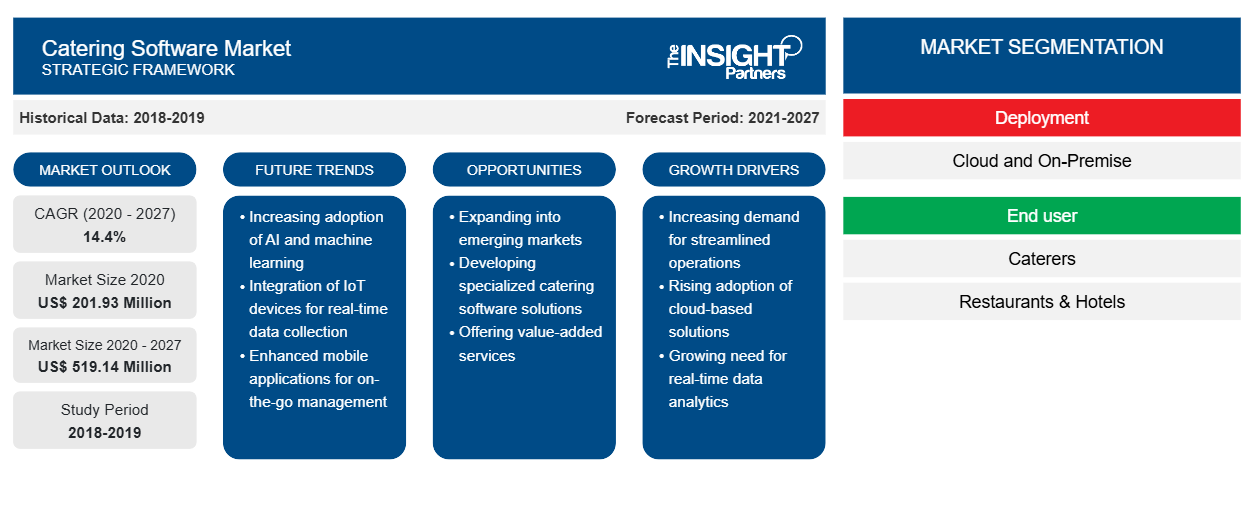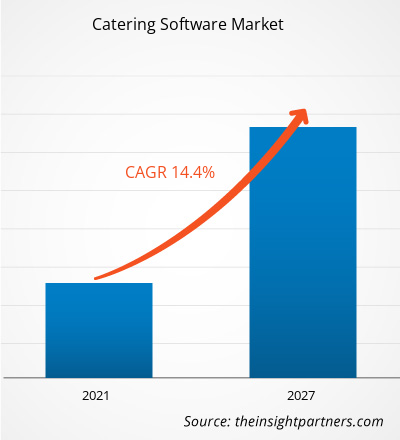Der Markt für Catering-Software soll von 201,93 Millionen US-Dollar im Jahr 2020 auf 519,14 Millionen US-Dollar im Jahr 2027 wachsen; von 2020 bis 2027 wird mit einer durchschnittlichen jährlichen Wachstumsrate von 14,4 % gerechnet.
Big-Data-Analysetechnologie zur Verbesserung des Catering-Betriebs trägt zum Wachstum des Marktes bei. Die Big-Data-Analysetechnologie hat ein enormes Potenzial, das Catering-Geschäft vollständig zu verändern. Die Einführung von Big-Data-Lösungen trägt dazu bei, die Effizienz von Vertriebs- und Produktionsnetzwerken in der gesamten Catering-Branche zu verbessern. Die Technologie ermöglicht die Verfolgung des gesamten Prozesses des Transports von Lieferungen. Mit Echtzeit-Einblicken können Kunden ihre Bestellungen auf ihren Geräten verfolgen und den Catering-Status überprüfen. Die Integration eines Analyse-Dashboards in die Catering-Software hilft dabei, die Leistung von Catering-Agenten zu verfolgen und zu bewerten. Außerdem muss jeder Stakeholder im Catering-Geschäft über relevante Daten zu seinen Produkten verfügen, einschließlich Daten zu Landwirten, Spediteuren und Einzelhändlern, endend mit Restaurants und Geschäften. Beispielsweise verwendet das KFC-Restaurant Big-Data-Tools, um Feedback von Kunden und Essensvorlieben zu analysieren, was zu besseren Kundenerlebnissen, Umsätzen und Gewinnen führt.
Die E-Commerce-Branche hat in den letzten Jahren in allen Regionen zahlreiche Veränderungen erlebt. Das Wachstum der Branche hat die Akteure auf dem Markt für Catering-Software dazu veranlasst , Big Data-Analysen zu nutzen, um intelligentere Geschäftsentscheidungen zu treffen. Die Technologie ermöglicht es Online-Händlern, Kundeninteraktionen über Kanäle wie Mobilgeräte, soziale Medien und Websites auszuwerten.
Passen Sie diesen Bericht Ihren Anforderungen an
Sie erhalten kostenlose Anpassungen an jedem Bericht, einschließlich Teilen dieses Berichts oder einer Analyse auf Länderebene, eines Excel-Datenpakets sowie tolle Angebote und Rabatte für Start-ups und Universitäten.
- Holen Sie sich die wichtigsten Markttrends aus diesem Bericht.Dieses KOSTENLOSE Beispiel umfasst eine Datenanalyse von Markttrends bis hin zu Schätzungen und Prognosen.
Auswirkungen der COVID-19-Pandemie auf den Catering-Softwaremarkt
Nach dem weltweiten Ausbruch der COVID-19-Pandemie waren einige Unternehmen aufgrund verschiedener Eindämmungsmaßnahmen von Regierungen auf der ganzen Welt gezwungen, ihre Geschäftstätigkeit einzuschränken. Die rasche Ausbreitung des Virus hat Regierungen auf der ganzen Welt dazu veranlasst, strenge Beschränkungen für die Bewegung von Personen und Fahrzeugen zu erlassen. Unternehmen, die zur Erzielung von Einnahmen auf physische Interaktion angewiesen sind, wurden durch die Sperrungen schwer geschädigt. Infolgedessen konzentrieren sich einige Unternehmen darauf, Konversionen, Interaktionen und Einnahmen durch digitale Medien zu steigern.lockdowns. As a result, some businesses are concentrating on increasing conversions, interactions, and revenue through digital media.
Markteinblicke – Catering-Softwaremarkt
Maschinelles Lernen revolutioniert das Cateringgeschäft
In der Gastronomie führen die unzureichende Gebietskartierung und das Ungleichgewicht zwischen Nachfrage und Ressourcenverfügbarkeit zu mehreren Herausforderungen. Maschinelles Lernen und künstliche Intelligenz (KI) sind die Grundlagen der Gastronomietechnologien der nächsten Generation. Diese Technologien ermöglichen es Systemen, aus aufgezeichneten Daten zu lernen, die Algorithmen, Muster und prädiktive Erkenntnisse umfassen. Mehrere Online-Lebensmittellieferunternehmen setzen die Technologie des maschinellen Lernens ein, um ihr Gastronomiegeschäft zu verbessern und die Effizienz ihrer Unternehmen zu steigern. Beispielsweise investiert Deliveroo, ein in Großbritannien ansässiges Lebensmittellieferunternehmen, in fortschrittliche Technologien wie maschinelles Lernen, um durch einen effektiveren Lebensmittellieferservice auf dem Markt wettbewerbsfähig zu bleiben. Glovo, ein in Spanien ansässiges Lebensmittellieferunternehmen, verwendet ebenfalls maschinelles Lernen, um die Wahrscheinlichkeit vorherzusagen, mit der die App aktiv bleibt. Daher wird erwartet, dass die Integration von maschinellem Lernen in Gastronomieunternehmen die Nachfrage nach Gastronomiesoftware im Prognosezeitraum steigern wird.
Bereitstellungsbasierte Erkenntnisse
Basierend auf dem Bereitstellungstyp ist der Markt für Catering-Software in Cloud und On-Premises segmentiert. Das Cloud-Segment hatte 2019 den größten Marktanteil.
Regionale Einblicke in den Catering-Softwaremarkt
Die regionalen Trends und Faktoren, die den Catering-Softwaremarkt während des Prognosezeitraums beeinflussen, wurden von den Analysten von Insight Partners ausführlich erläutert. In diesem Abschnitt werden auch die Marktsegmente und die Geografie von Catering-Software in Nordamerika, Europa, im asiatisch-pazifischen Raum, im Nahen Osten und Afrika sowie in Süd- und Mittelamerika erörtert.

- Erhalten Sie regionale Daten zum Catering-Softwaremarkt
Umfang des Marktberichts zur Catering-Software
| Berichtsattribut | Details |
|---|---|
| Marktgröße im Jahr 2020 | 201,93 Millionen US-Dollar |
| Marktgröße bis 2027 | 519,14 Millionen US-Dollar |
| Globale CAGR (2020 - 2027) | 14,4 % |
| Historische Daten | 2018-2019 |
| Prognosezeitraum | 2021-2027 |
| Abgedeckte Segmente | Nach Bereitstellung
|
| Abgedeckte Regionen und Länder | Nordamerika
|
| Marktführer und wichtige Unternehmensprofile |
|
Dichte der Marktteilnehmer für Catering-Software: Die Auswirkungen auf die Geschäftsdynamik verstehen
Der Markt für Catering-Software wächst rasant, angetrieben durch die steigende Nachfrage der Endnutzer aufgrund von Faktoren wie sich entwickelnden Verbraucherpräferenzen, technologischen Fortschritten und einem größeren Bewusstsein für die Vorteile des Produkts. Mit steigender Nachfrage erweitern Unternehmen ihr Angebot, entwickeln Innovationen, um die Bedürfnisse der Verbraucher zu erfüllen, und nutzen neue Trends, was das Marktwachstum weiter ankurbelt.
Die Marktteilnehmerdichte bezieht sich auf die Verteilung von Firmen oder Unternehmen, die in einem bestimmten Markt oder einer bestimmten Branche tätig sind. Sie gibt an, wie viele Wettbewerber (Marktteilnehmer) in einem bestimmten Marktraum im Verhältnis zu seiner Größe oder seinem gesamten Marktwert präsent sind.
Die wichtigsten auf dem Catering-Softwaremarkt tätigen Unternehmen sind:
- Aptus Systems Ltd.
- Bessere Caterer, Inc.
- Caterease Software
- CaterTrax, Inc.
- CaterZen von Restaurant & Catering Systems
Haftungsausschluss : Die oben aufgeführten Unternehmen sind nicht in einer bestimmten Reihenfolge aufgeführt.

- Überblick über die wichtigsten Akteure auf dem Catering-Softwaremarkt
Die Akteure auf dem Markt für Catering-Software konzentrieren sich hauptsächlich auf die Entwicklung fortschrittlicher und effizienter Produkte.
- Im Jahr 2020 hat CaterZen seit Anfang März Programmierstunden investiert, um sicherzustellen, dass Restaurants und Caterer ihren Betrieb durch starke Konzentration auf Online-Bestellungen und Essenslieferungen weiterführen können.
- Im Jahr 2020 führte Flex Catering das Catering-KDS (Kitchen Display System) ein, eine Art digitaler Bildschirm, der gedruckte oder handschriftliche Ticketbestellungen in Restaurants und Lebensmittelunternehmen ersetzt.
Der Markt für Gastronomiesoftware ist wie folgt segmentiert:
Globale Catering-Software – nach Bereitstellung
- Wolke
- Vor Ort
Globale Catering-Software – Nach Endbenutzer
- Catering
- Restaurants & Hotels
- Sonstiges
Globaler Catering-Softwaremarkt – nach Geografie
Nordamerika
- UNS
- Kanada
- Mexiko
Europa
- Frankreich
- Deutschland
- Italien
- Russland
- Vereinigtes Königreich
- Restliches Europa
Asien-Pazifik (APAC)
- Japan
- China
- Australien
- Indien
- Südkorea
- Restlicher Asien-Pazifik-Raum
Naher Osten und Afrika (MEA)
- Saudi-Arabien
- Vereinigte Arabische Emirate
- Südafrika
- Rest von MEA
Südamerika (SAM)
- Brasilien
- Argentinien
- Rest von SAM
Markt für Catering-Software – Firmenprofile
- Aptus Systems Ltd.
- Bessere Caterer, Inc.
- Caterease Software
- CaterTrax, Inc.
- CaterZen von Restaurant & Catering Systems
- Flexibles Catering
- FoodStorm Catering-Software (CaterXpress)
- Planungs-Pod (My Wedding Workbook, LLC)
- Profit Systems Inc.
- Pxier
- Historische Analyse (2 Jahre), Basisjahr, Prognose (7 Jahre) mit CAGR
- PEST- und SWOT-Analyse
- Marktgröße Wert/Volumen – Global, Regional, Land
- Branche und Wettbewerbsumfeld
- Excel-Datensatz


- Carbon Fiber Market
- Aerospace Forging Market
- Cosmetic Bioactive Ingredients Market
- Bioremediation Technology and Services Market
- Analog-to-Digital Converter Market
- Unit Heater Market
- Molecular Diagnostics Market
- Identity Verification Market
- Airport Runway FOD Detection Systems Market
- Vessel Monitoring System Market

Report Coverage
Revenue forecast, Company Analysis, Industry landscape, Growth factors, and Trends

Segment Covered
This text is related
to segments covered.

Regional Scope
North America, Europe, Asia Pacific, Middle East & Africa, South & Central America

Country Scope
This text is related
to country scope.
Häufig gestellte Fragen
The catering software market is led by cloud segment with highest share and is expected to dominate in the forecast period. The cloud segment generates the majority of the demand since it is comparatively less expensive and due to strong network infrastructure in developed countries. In addition, the cloud-based browser isolation software vendors are highly focused on developing a high-level security patch in order to eliminate the risk of cyber-attack.
The growth of the catering software market is primarily attributed to growing popularity of e-commerce platforms. Moreover, increasing integration of payment gateway, thereby substantially driving the catering software software market.
The Big Data analytics technology has enormous potential to completely transform the catering business. The adoption of Big Data solutions helps improve the efficiency of distribution and production networks in the overall catering industry. The technology allows tracking the entire process of the transportation of supplies. With real-time insights, customers can track their purchase orders on their devices and check the catering status. The integration of an analytics dashboard in catering software helps track and evaluate the performance of catering agents. Also, every stakeholder in the catering business must have relevant data on their products, including data related to farmers, shippers, and retailers, ending with restaurants and shops.
Trends and growth analysis reports related to Technology, Media and Telecommunications : READ MORE..
The List Companies - Catering Software Market
- Aptus Systems Ltd.
- Better Cater, Inc
- Caterease Software
- CaterTrax, Inc.
- CaterZen by Restaurant & Catering Systems
- Flex Catering
- FoodStorm Catering Software (CaterXpress)
- Planning Pod (My Wedding Workbook, LLC)
- Profit Systems Inc.
- Pxier
The Insight Partners performs research in 4 major stages: Data Collection & Secondary Research, Primary Research, Data Analysis and Data Triangulation & Final Review.
- Data Collection and Secondary Research:
As a market research and consulting firm operating from a decade, we have published and advised several client across the globe. First step for any study will start with an assessment of currently available data and insights from existing reports. Further, historical and current market information is collected from Investor Presentations, Annual Reports, SEC Filings, etc., and other information related to company’s performance and market positioning are gathered from Paid Databases (Factiva, Hoovers, and Reuters) and various other publications available in public domain.
Several associations trade associates, technical forums, institutes, societies and organization are accessed to gain technical as well as market related insights through their publications such as research papers, blogs and press releases related to the studies are referred to get cues about the market. Further, white papers, journals, magazines, and other news articles published in last 3 years are scrutinized and analyzed to understand the current market trends.
- Primary Research:
The primarily interview analysis comprise of data obtained from industry participants interview and answers to survey questions gathered by in-house primary team.
For primary research, interviews are conducted with industry experts/CEOs/Marketing Managers/VPs/Subject Matter Experts from both demand and supply side to get a 360-degree view of the market. The primary team conducts several interviews based on the complexity of the markets to understand the various market trends and dynamics which makes research more credible and precise.
A typical research interview fulfils the following functions:
- Provides first-hand information on the market size, market trends, growth trends, competitive landscape, and outlook
- Validates and strengthens in-house secondary research findings
- Develops the analysis team’s expertise and market understanding
Primary research involves email interactions and telephone interviews for each market, category, segment, and sub-segment across geographies. The participants who typically take part in such a process include, but are not limited to:
- Industry participants: VPs, business development managers, market intelligence managers and national sales managers
- Outside experts: Valuation experts, research analysts and key opinion leaders specializing in the electronics and semiconductor industry.
Below is the breakup of our primary respondents by company, designation, and region:

Once we receive the confirmation from primary research sources or primary respondents, we finalize the base year market estimation and forecast the data as per the macroeconomic and microeconomic factors assessed during data collection.
- Data Analysis:
Once data is validated through both secondary as well as primary respondents, we finalize the market estimations by hypothesis formulation and factor analysis at regional and country level.
- Macro-Economic Factor Analysis:
We analyse macroeconomic indicators such the gross domestic product (GDP), increase in the demand for goods and services across industries, technological advancement, regional economic growth, governmental policies, the influence of COVID-19, PEST analysis, and other aspects. This analysis aids in setting benchmarks for various nations/regions and approximating market splits. Additionally, the general trend of the aforementioned components aid in determining the market's development possibilities.
- Country Level Data:
Various factors that are especially aligned to the country are taken into account to determine the market size for a certain area and country, including the presence of vendors, such as headquarters and offices, the country's GDP, demand patterns, and industry growth. To comprehend the market dynamics for the nation, a number of growth variables, inhibitors, application areas, and current market trends are researched. The aforementioned elements aid in determining the country's overall market's growth potential.
- Company Profile:
The “Table of Contents” is formulated by listing and analyzing more than 25 - 30 companies operating in the market ecosystem across geographies. However, we profile only 10 companies as a standard practice in our syndicate reports. These 10 companies comprise leading, emerging, and regional players. Nonetheless, our analysis is not restricted to the 10 listed companies, we also analyze other companies present in the market to develop a holistic view and understand the prevailing trends. The “Company Profiles” section in the report covers key facts, business description, products & services, financial information, SWOT analysis, and key developments. The financial information presented is extracted from the annual reports and official documents of the publicly listed companies. Upon collecting the information for the sections of respective companies, we verify them via various primary sources and then compile the data in respective company profiles. The company level information helps us in deriving the base number as well as in forecasting the market size.
- Developing Base Number:
Aggregation of sales statistics (2020-2022) and macro-economic factor, and other secondary and primary research insights are utilized to arrive at base number and related market shares for 2022. The data gaps are identified in this step and relevant market data is analyzed, collected from paid primary interviews or databases. On finalizing the base year market size, forecasts are developed on the basis of macro-economic, industry and market growth factors and company level analysis.
- Data Triangulation and Final Review:
The market findings and base year market size calculations are validated from supply as well as demand side. Demand side validations are based on macro-economic factor analysis and benchmarks for respective regions and countries. In case of supply side validations, revenues of major companies are estimated (in case not available) based on industry benchmark, approximate number of employees, product portfolio, and primary interviews revenues are gathered. Further revenue from target product/service segment is assessed to avoid overshooting of market statistics. In case of heavy deviations between supply and demand side values, all thes steps are repeated to achieve synchronization.
We follow an iterative model, wherein we share our research findings with Subject Matter Experts (SME’s) and Key Opinion Leaders (KOLs) until consensus view of the market is not formulated – this model negates any drastic deviation in the opinions of experts. Only validated and universally acceptable research findings are quoted in our reports.
We have important check points that we use to validate our research findings – which we call – data triangulation, where we validate the information, we generate from secondary sources with primary interviews and then we re-validate with our internal data bases and Subject matter experts. This comprehensive model enables us to deliver high quality, reliable data in shortest possible time.


 Holen Sie sich ein kostenloses Muster für diesen Bericht
Holen Sie sich ein kostenloses Muster für diesen Bericht